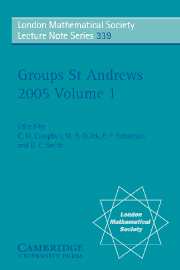Book contents
- Frontmatter
- Contents
- Introduction
- Aspects of infinite permutation groups
- Self-similarity and branching in group theory
- On surface groups: motivating examples in combinatorial group theory
- Nilpotent p-algebras and factorized p-groups
- Classification of finite groups by the number of element centralizers
- Algorithmic use of the Mal'cev correspondence
- Minimal but inefficient presentations for semi-direct products of finite cyclic monoids
- The modular isomorphism problem for finite p-groups with a cyclic subgroup of index p2
- On one-generated formations
- New results on products of finite groups
- Radical locally finite T-groups
- Explicit tilting complexes for the Broué conjecture on 3-blocks
- Conjugacy classes of p-regular elements in p-solvable groups
- An algorithm for the unit group of the Burnside ring of a finite group
- Integral group ring of the first Mathieu simple group
- Embedding properties in direct products
- Malcev presentations for subsemigroups of groups — a survey
- Finite groups with extremal conditions on sizes of conjugacy classes and on degrees of irreducible characters
- Conjugacy class structure in simple algebraic groups
- On automorphisms of products of groups
- Linear groups with infinite central dimension
- G-automata, counter languages and the Chomsky hierarchy
- An embedding theorem for groups universally equivalent to free nilpotent groups
- Irreducible word problems in groups
- Recent growth results
Minimal but inefficient presentations for semi-direct products of finite cyclic monoids
Published online by Cambridge University Press: 07 May 2010
- Frontmatter
- Contents
- Introduction
- Aspects of infinite permutation groups
- Self-similarity and branching in group theory
- On surface groups: motivating examples in combinatorial group theory
- Nilpotent p-algebras and factorized p-groups
- Classification of finite groups by the number of element centralizers
- Algorithmic use of the Mal'cev correspondence
- Minimal but inefficient presentations for semi-direct products of finite cyclic monoids
- The modular isomorphism problem for finite p-groups with a cyclic subgroup of index p2
- On one-generated formations
- New results on products of finite groups
- Radical locally finite T-groups
- Explicit tilting complexes for the Broué conjecture on 3-blocks
- Conjugacy classes of p-regular elements in p-solvable groups
- An algorithm for the unit group of the Burnside ring of a finite group
- Integral group ring of the first Mathieu simple group
- Embedding properties in direct products
- Malcev presentations for subsemigroups of groups — a survey
- Finite groups with extremal conditions on sizes of conjugacy classes and on degrees of irreducible characters
- Conjugacy class structure in simple algebraic groups
- On automorphisms of products of groups
- Linear groups with infinite central dimension
- G-automata, counter languages and the Chomsky hierarchy
- An embedding theorem for groups universally equivalent to free nilpotent groups
- Irreducible word problems in groups
- Recent growth results
Summary
Abstract
Let A and K be arbitrary two monoids. For any connecting monoid homomorphism θ: A → End(K), let M = K ⋊θA be the corresponding monoid semi-direct product. In [2], Cevik discussed necessary and sufficient conditions for the standard presentation of M to be efficient (or, equivalently, p-Cockcroft for any prime p or 0), and then, as an application of this, he showed the efficiency for the presentation, say PM, of the semi-direct product of any two finite cyclic monoids. As a main result of this paper, we give sufficient conditions for PM to be minimal but not efficient. To do that we will use the same method as given in [3].
AMS Classification: 20L05, 20M05, 20M15, 20M50, 20M99.
Keywords: Minimality, Efficiency, p-Cockcroft property, Finite cyclic monoids.
Introduction
Let P = [X ; r] be a monoid presentation where a typical element R ∈ r has the form R+ = R−. Here R+, R− are words on X (that is, elements of the free monoid F(X) on X). The monoid defined by [X ; r] is the quotient of F(X) by the smallest congruence generated by r.
We have a (Squier) graph Γ = Γ (X; r) associated with [X ; r], where the vertices are the elements of F(X) and the edges are the 4-tuples e = (U,R, ε, V) where U, V ∈ F(X), R ∈ r and ε = ±1.
- Type
- Chapter
- Information
- Groups St Andrews 2005 , pp. 170 - 185Publisher: Cambridge University PressPrint publication year: 2007
- 1
- Cited by



